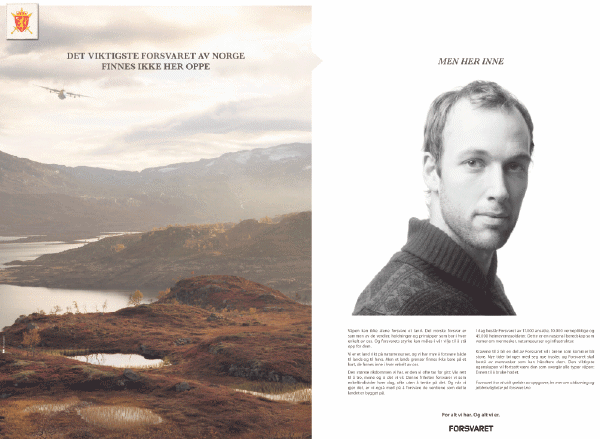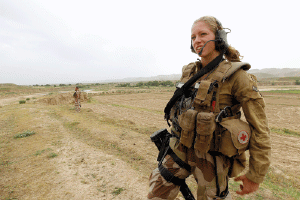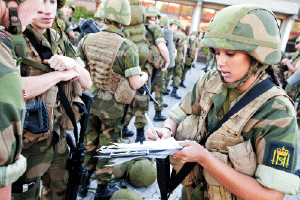3 Diversity
The main objective for the competency reform is to ensure operative capability. To achieve this, we need to increase the diversity of the organisation. Diversity is a question of having a varied composition among personnel in terms of both visible and invisible differences. Visible diversity refers to variables such as gender, ethnicity, age and physical abilities. Invisible diversity refers to factors such as education, experience, sexual orientation, religion, philosophy, competency, social or geographical background.
Numerous organisations within society give greater priority than before to the correlation between diversity and solving tasks. Diversity, difference and variation are all necessary to achieve the breadth of competency and adaptability required by modern competency organisations and for organisations operating in a world which is changing at a more rapid pace than before. These factors are also required to ensure that a high-tech defence is able to master complex situations, tasks and challenges.
The requirement for diverse competency has increased for all organisations in the defence sector. However, it is particularly dominant for the military organisations. The Armed Forces have an historical inheritance of cultures and systems for selection, recruitment and career development which, in addition to a hierarchical organisation and internal socialisation processes, excessively promotes conformity and obstructs diversity. This becomes a challenge as a wider range of tasks and a more rapid rate of change demand greater diversity in terms of competency.

Figure 3.1 Facsimile from the Armed Forces campaign; “For all we have. And all we are.”
3.1 Diversity allows for variation and adaptability
The need for diversity, when applying an extended interpretation of the concept, has increased over time for the defence sector. Diversity is important because it correlates with values such as justice, legality, legitimacy and ethics. The defence sector must reflect the society it is charged with protecting. By including a broader section of the population in defence, it will be easier for more groups of people to identify with the Armed Forces, which will help enhance legitimacy. Primarily however, diversity is important for a modern defence as a premise for the necessary breadth of competency, capacity for innovation and the ability to make several alternative actions available at the same time. Diversity therefore provides increased operative capability.
A wider range of perspectives among employees implies that complex problems can be aired from different sides. This provides the organisation with an increased capacity to understand and solve current and future tasks and challenges. It is therefore essential to ensure that employees who have a different background than the majority stay in the organisation, and that employees feel they are valued and protected.
The complexity and range of change experienced by the current rapid reaction capability defence requires a diverse range of competency, high adaptability and employees who solve challenges as a team. The work involved has become far too complex for generalisation among work distribution. A number of functions require in-depth understanding of systems and totality, and communication skills. By attracting and recruiting employees from a broader section of society, the defence sector is more able to recruit from the most suitable candidates on a labour market where competition for talented candidates is tough.
Neither is it sufficient to recruit personnel who principally represent difference in order to ensure the required level of diversity. If such persons have to make use of adaptation strategies to function within the organisation, the potential for added value provided by diversity is not exploited. If you shape people into copies of those already in the organisation, you will get old answers to new challenges. These kinds of organisations may become irrelevant and find it difficult to recruit and retain employees. Diversity is therefore no guarantee for added value but only has an impact when the diversity among personnel is of significance for the daily operations, strategies and choices made. This necessitates an organisational culture which is open and change-oriented, which listens to differing opinions when decisions have to be made.

Figure 3.2 On a mission with the POMLT (police operational monitoring liaison team), which comprises Norwegian and American soldiers and civilian Norwegian police, in Dowlatabad in the Faryab province, Afghanistan.
Photo: Media centre for the Norwegian Armed Forces/Torbjørn Kjosvold
Demographic factors and other, more invisible dimensions of diversity do not contradict each other. If both perspectives are fully integrated, you gain much more potential to create the necessary level of variation and breadth within the composition of competency.
Diversity within the Armed Forces has mainly been addressed as a question of improving the gender balance within the organisation. Despite a major focus on the political and organisational aspects and research, very little progress has been made on the work to increase the ratio of female employees. The project implemented by the Norwegian Defence Research Establishment – “Research on Age Cohorts for the NorAF” – indicates that a higher ratio of women leave the defence sector than men, particularly women under the age of 30. The research also indicates that it is internal processes within the Armed Forces which contribute towards women and men becoming more equal once they have been recruited to the organisation. These processes include uniforms, common education and training, sense of humour, personal evaluations, application rounds and catalogues of requirements.
The most important factor for increasing the ratio of women is to recruit more women from the military educational system and ensure that these women want to stay in the Armed Forces. Another method may be to recruit women with a civilian education and offer them supplementary military education. The decisive factor for increasing diversity, including the ratio of women, is to make sure the defence sector is perceived as an attractive employer by a broader section of society, so that the sector is thus able to recruit from the best candidates on the labour market.
3.2 Balance between diversity and conformity
The defence sector needs both conformity and diversity to be able to carry out its assignments. A certain level of conformity is required to create stability and functionality, and to make the organisation more able to standardise processes in relation to uniform targets. At the same time, a diverse range of perspectives and philosophies is necessary to generate innovation and adaptability.
Numerous operative situations will require the need for definite structures, processes and system. These take the form of procedures, standards and doctrines. When a military unit is under fire, all persons within that unit must react in accordance with their training and skills and their reactions must come as an automatic reflex. As a result, some functional requirements may be necessary in military situations and may obstruct diversity. At the same time however, it is essential to continuously question whether these requirements are objective and have a professional basis, or whether they are the result of traditions and culture.1
Another type of conformity involves values and attitudes. The profession of a soldier requires a high ethical standard, for example for conduct during operations, respect for other cultures and religions. This is required for both ethical and functional reasons. Good attitudes and positive conduct are decisive in military operations and for other tasks. An increase in differences among employees therefore makes this process all the more important. The defence sector therefore has to take a conscious approach to attitudes and values which are not acceptable, for example zero tolerance of sexual harassment, and areas which can pave the way for, or even stimulate, different points of view. In addition to the work on attitudes, ethics and management, a process which was launched in 2006 and is described in chapter 2.5, a new publication was issued in the autumn of 2012 entitled “The value base for the defence sector”. The core values of openness, far-sightedness, respect, responsibility and courage shall form the basis for all activities within the defence sector.
3.3 How to work with diversity within the defence sector?
Diversity is a question of recruitment, development and retention of different people. It involves identifying the correlation between who is recruited to the organisation, how different employees are integrated in the organisation and how they are allowed to contribute with their competency and uniqueness. At a defence sector level, increased scope for the flow of competency between the organisations helps provide new perspectives from related organisations. Increased cooperation and flow of competency with other parties in society is also a step in the right direction.
The sector must also attract candidates from a wider section of society. The Norwegian Defence Estates Agency is currently assessing the potential for a trainee scheme whereby graduates can gain work experience and become familiar with different parts of the organisation. The Norwegian Defence Research Establishment has recorded a positive outcome from its summer student scheme which attracts a high number of applicants from the major educational establishments and has also helped in recruiting a higher ratio of females. Public opinion polls indicate an increased interest among women in a career with the Armed Forces, which has emerged in parallel with the the campaign entitled “For all we have. And all we are.” The purpose of the campaign is to portray the diversity of opportunities and careers available within the modern day Armed Forces. Such experience can be of value for other organisations within the defence sector.
Textbox 3.1 Summer student scheme generates goal-oriented recruitment
More than 30 percent of current scientific employees at the Norwegian Defence Research Establishment have at one time taken part in the summer scheme for students.
It used to be possible for students and graduates to do their national service on research projects with the establishment. This was an excellent source for recruitment, but today is practically nonexistent. As a replacement, the Norwegian Defence Research Establishment has made further developments to and specified new targets for its summer student scheme. Every year, the establishment welcomes close to 60 students who spend eight to ten weeks putting theory into practice. The scheme is open to students from Universities and colleges. The tasks set for the students are adapted to the expected level of expertise and experience, or perhaps a little higher.
More than 600 students apply to the scheme every year. The most highly qualified students are given the opportunity to try their hand as researchers. Once the summer scheme has been completed, the students are evaluated. This allows the Establishment to identify possible candidates for future positions with the Establishment, and to monitor the students after they leave the scheme. A good number of students return every summer until they graduate. Many choose to take a Master's degree or even a PhD at the Establishment.
The summer student scheme is a great tool for goal-oriented recruitment both in terms of expertise and diversity. In the period from 2004 to 2012, the Norwegian Defence Research Establishment has increased its ratio of female scientific employees from 12 to 21 percent. One of the methods applied to achieve this was to increase the ratio of women in the summer student scheme. More than 30 percent of the summer students have been women.
A holistic approach to diversity requires establishing relationships with people who cannot primarily be categorised according to demographics, but who think differently, have different behavioural patterns and different views of the world at large. However, this approach presents somewhat of a challenge as these factors are difficult to gauge. The defence sector has to develop methods for measurement of diversity in addition to demographic factors, and also requires new methods and tools for recruitment and selection. It is therefore important to maintain a continual focus on the significance of culture, how managers can influence the working climate and zero tolerance of actions which are in breach of the values, attitudes and standards required by the sector.
It is also necessary to continue investing in research in order to enhance knowledge of how both women and men perceive the defence sector as an employer and how employees feel they are treated at work. This research will play an important role in identifying structural deterrents which imply that the sector does not achieve the required level of diversity.
Recruitment measures and selection requirements within the Armed Forces must continuously be assessed and adapted to the actual competency requirement. The need for a greater diversity of competency also generates a need to expand recruitment and introduce differentiated selection. The different tasks of the Armed Forces place different requirements on intellectual and physical characteristics and skills. Compulsory military service will remain an extremely important source for recruitment to the Armed Forces. One of the initiatives implemented to increase the ratio of women is to introduce an obligatory examination of young women for military service. The impact of this initiative will be evaluated in 2014 and new measures to increase the ratio of women will be assessed at that time. Although compulsory military service and the educational system will remain the main source of entry to the Armed Forces, other recruitment methods are required at different levels within the organisation. Recruitment from the civil sector could prove an important method for increasing diversity and improving the gender balance in the military organisation.
The requirement for a greater diversity of competency and a more diversified personnel also necessitates a greater differentiation in how competency is developed and applied. This will involve introducing a wider range of career paths and, in particular, horizontal career cycles. In addition, a vertical career cycle should allow for a much wider diversity within the organisation than purely operative. Moreover, a higher level of facilitation is required for flexible and individually adapted career cycles which allow for a wide number of family types, dual-career families and the employees’ need for a personnel policy which is adapted to their stage in life. The currently available uniform career path implies that the educational system targets vertical career development to an excessive degree. The incentive system must also be adapted to an increased need for differentiation and career paths which are not vertical. The perspective of diversity will therefore play a key role in the process to develop personnel schemes for the future, a review of the payroll system and the further development of the educational system.

Figure 3.3 Soldier from the King's Guard emergency squad
Photo: Media centre for the Norwegian Armed Forces/Lars Magne Hovtun